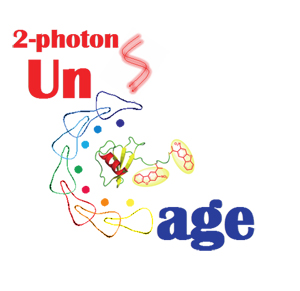The first two-photon-activatable chemokine and photon-guided cell migration reported in Nature Communications
The first two-photon-activatable chemokine and photon-guided cell migration reported in Nature Communications
As reported in a paper entitled "Chemical synthesis of a two-photon-activatable chemokine and photon-guided lymphocyte migration in vivo" published in Nature Communications on May 26, 2015, an interdisciplinary collaboration between the group of Professor Hai Qi in the School of Medicine and the group of Professor Lei Liu in the Department of Chemistry has led to the creation of the first two-photon-activatable chemokine, the demonstration of light-guided manipulation of cell migration in living animals, thereby opening a new avenue for studying immune cell dynamics and spatiotemporal regulation of cell fate determination in vivo. Xin Chen, a PhD student from the School of Medicine, Shan Tang, a PhD student from the Department of Chemistry, and Dr. Ji-Shen Zheng, an associate professor from the High Magnetic Field Laboratory, Chinese Academy of Sciences, are first authors contributing to this paper equally.

Picture: two-photon-activatable chemokine
Chemokine-guided lymphocyte positioning in tissues is crucial for normal operation of the immune system and plays important roles in major diseases such as cancer and autoimmunity. Direct, real-time manipulation and measurement of single-cell responses to chemokines is highly desired for investigating the cell biology of lymphocyte migration in vivo. These authors report the development of the first two-photon-activatable human CCL5 chemokine through efficient one-pot total chemical synthesis in milligram scale. By spatiotemporally controlled photoactivation, they show at the single-cell level that T cells perceive the directional cue without relying on PI3K activities, which are nonetheless required for persistent migration over an extended period of time. By intravital imaging, they demonstrate artificial T-cell positioning in cutaneous tissues and lymph nodes. This work establishes a general strategy to develop high-quality photo-activatable protein agents through tailor-designed caging of multiple residues and highlights the potential of photo-activatable chemokines for understanding and potential therapeutic manipulation of cell positioning and position-controlled cell behaviours in vivo.
Professor Hai Qi specializes in studies of cellular dynamics and cell-cell interactions underlying the immune responses and Prof. Lei Liu is an expert in synthetic protein chemistry with a keen interest in using chemical tools to probe biological processes. This work represents a striking example for successful interdisciplinary research being promoted at the Tsinghua University.
http://www.nature.com/ncomms/2015/150526/ncomms8220/full/ncomms8220.html

